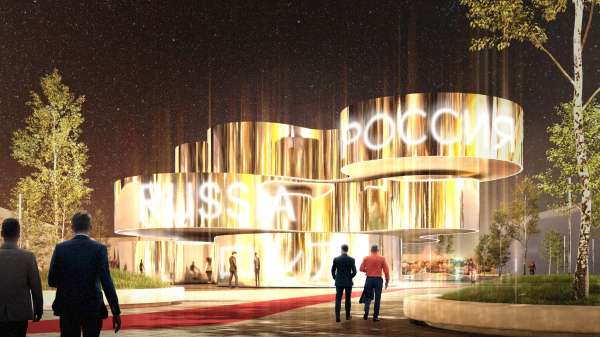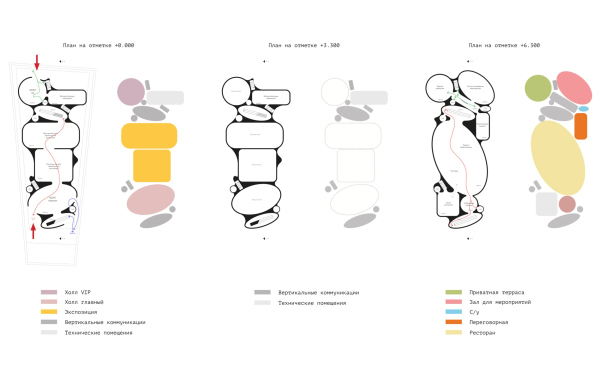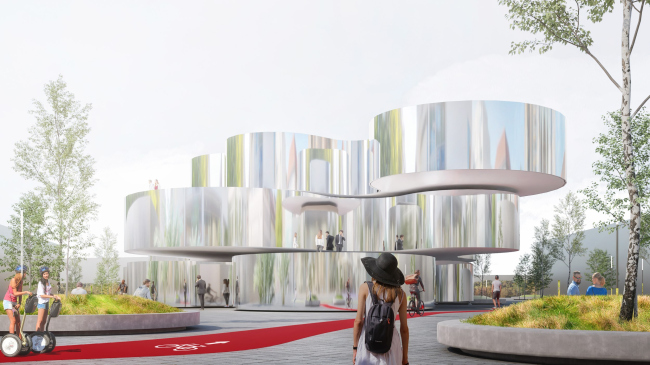|
Published on Archi.ru (https://archi.ru) |
|
| 22.04.2024 | |
|
Mirrors Everywhere |
|
|
Julia Tarabarina |
|
| Studio: | |
| Novoe | |
|
The project by Sergey Nebotov, Anastasia Gritskova, and the architectural company “Novoe” was created for the Russian pavilion at EXPO 2025, but within the framework of another competition, which, as we learned, took place even earlier, in 2021. At that time, the competition theme was “digital twins”, and there was minimal time for work, so the project, according to the architect himself, was more of a “student assignment”. Nevertheless, this project is interesting for its plan bordering on similarity with Baroque projects and the emblem of the exhibition, as well as its diverse and comprehensive reflectiveness. We spent quite a long time studying the competition projects for the Russian pavilion at EXPO in Osaka – the projects submitted for the competition, the results of which were never announced due to our country’s withdrawal from the 2025 World Expo – and discovered that there was not just one competition, but two in fact. The main one, all six projects of which we managed to collect, took place in the middle of 2022, and the first one – at the end of 2021. We also managed to obtain one of the projects from the first competition for publication. Russia Pavilion at the EXPO in Osaka. The competition draft for the preliminary concept. “Mirage” pavilionCopyright: © Novoe ArchitectsDuring the day, it was meant to reflect everything around it, while in the evening, the media part of the façade would complement reality with images, inscriptions, patterns, and colors.  Russia Pavilion at the EXPO in Osaka. The competition draft for the preliminary concept. “Mirage” pavilionCopyright: © Novoe Architects Russia Pavilion at the EXPO in Osaka. The competition draft for the preliminary concept. “Mirage” pavilionCopyright: © Novoe ArchitectsThe bands of the facades wind not in a random fashion, but in a quite motivated way, as the pavilion is literally assembled from volumes of various shapes: squares and rectangles, ovals and circles, larger and smaller ones – the plan resembles an assemblage of well-hewn pebbles, all-but-identical, yet still different in their original shape.  Russia Pavilion at the EXPO in Osaka. The competition draft for the preliminary concept. “Mirage” pavilionCopyright: © Novoe Architects Russia Pavilion at the EXPO in Osaka. The competition draft for the preliminary concept. “Mirage” pavilionCopyright: © Novoe ArchitectsThe plan is reminiscent of the experiments of 17th-century Baroque architects, and the radical ones, too – not like Bernini, but like Borromini – where ovals, exedrae, and other non-trivial geometric figures coexisted, embellishing the space. No less does the plan resemble the emblem of EXPO 2025, which was already known by that time, shown in 2020 – the emblem is composed of different-sized circles and ovals, asymmetrically assembled in a ring. The resemblance is indirect – it would be an embarrassment if it was – but it makes Sergey Nebotov’s idea internally akin to the symbol of the World Expo. It’s curious that the architects don’t mention it – either they didn’t think about it at all or they thought that if everything goes ahead, it will be understood anyway. EXPO 2025 emblemCopyright: © Novoe ArchitectsThe fact is that the twists of the mirrored bands are not arbitrary, but motivated by the shape and volumes of the halls. Since the forms are juxtaposed with a significant overlap, “terrace” balconies are formed, from which one could survey the surroundings of the exhibition, and the cantilevers. Mirror-like quality, it should be noted, in this project extends far beyond the facades. On the operable roof, Sergey Nebotov proposed a Water Garden – essentially, a pool. According to the concept, you could sit by the water, or even walk on it, but most importantly – it would reflect the sky, emphasizing that we have one sky, common to all. “One Sky” is also one of the ideas of EXPO 2025. So mirrors were everywhere in this project. Of different kinds. |
|

